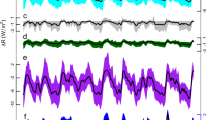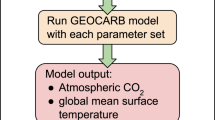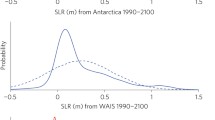Abstract
Combining instrumental period evidence regarding equilibrium climate sensitivity with largely independent paleoclimate proxy evidence should enable a more constrained sensitivity estimate to be obtained. Previous, subjective Bayesian approaches involved selection of a prior probability distribution reflecting the investigators’ beliefs about climate sensitivity. Here a recently developed approach employing two different statistical methods—objective Bayesian and frequentist likelihood-ratio—is used to combine instrumental period and paleoclimate evidence based on data presented and assessments made in the IPCC Fifth Assessment Report. Probabilistic estimates from each source of evidence are represented by posterior probability density functions (PDFs) of physically-appropriate form that can be uniquely factored into a likelihood function and a noninformative prior distribution. The three-parameter form is shown accurately to fit a wide range of estimated climate sensitivity PDFs. The likelihood functions relating to the probabilistic estimates from the two sources are multiplicatively combined and a prior is derived that is noninformative for inference from the combined evidence. A posterior PDF that incorporates the evidence from both sources is produced using a single-step approach, which avoids the order-dependency that would arise if Bayesian updating were used. Results are compared with an alternative approach using the frequentist signed root likelihood ratio method. Results from these two methods are effectively identical, and provide a 5–95% range for climate sensitivity of 1.1–4.05 K (median 1.87 K).



Similar content being viewed by others
References
Aldrin M et al (2012) Bayesian estimation of climate sensitivity based on a simple climate model fitted to observations of hemispheric temperatures and global ocean heat content. Environmetrics 23:253–271
Allen MR, Frame DJ, Huntingford C, Jones CD, Lowe JA, Meinshausen M, Meinshausen N (2009) Warming caused by cumulative carbon emissions towards the trillionth tonne. Nature 458:1163–1166
Andronova NG, Schlesinger ME (2001) Objective estimation of the probability density function for climate sensitivity. J Geophys Res 106(D19):22605–22611
Annan JD, Hargreaves JC (2006) Using multiple observationally-based constraints to estimate climate sensitivity. Geophys Res Lett 33:L06704
Annan JD, Hargreaves JC (2011) On the generation and interpretation of probabilistic estimates of climate sensitivity. Clim Change 104(3–4):423–436
Annan JD, Hargreaves JC (2013) A new global reconstruction of temperature changes at the Last Glacial Maximum. Clim Past 9:367–376
Annan JD, Hargreaves JC, Ohgaito R, Abe-Ouchi A, Emori S (2005) Efficiently constraining climate sensitivity with ensembles of paleoclimate simulations. Sci Online Lett Atmos 1:181–184
Bayes T (1763) An essay towards solving a problem in the doctrine of chances. Philos Trans R Soc Lond 53:370–418 [54(1764):269–325. Reprinted in Biometrika 45(1958):293–315]
Berger J (2006) The case for objective Bayesian analysis. Bayesian Anal 1(3):385–402
Berger JO, Bernardo JM (1992) On the development of reference priors (with discussion). In: Bernardo JM, Berger JO, Dawid AP, Smith AFM (eds) Bayesian statistics 4. Oxford University Press, Oxford, pp 35–60
Bernardo JM (1979) Reference posterior distributions for Bayesian inference (with discussion). J R Stat Soc Ser B 41:113–147
Bernardo JM (2009) Modern Bayesian inference: foundations and objective methods. In: Bandyopadhyay P, Forster M (eds) Philosophy of statistics. North Holland, Oxford, pp 263–306
Chylek P, Lohmann U (2008) Aerosol radiative forcing and climate sensitivity deduced from the last glacial maximum to Holocene transition. Geophys Res Lett 35:L04804
Colman R, McAvaney B (2009) Climate feedbacks under a very broad range of forcing. Geophys Res Lett 36:L01702. doi:10.1029/2008GL036268
Forest CE, Stone PH, Sokolov AP (2006) Estimated PDFs of climate system properties including natural and anthropogenic forcings. Geophys Res Lett 33:L01705. doi:10.1029/2005GL023977
Forster de PMF, Gregory JM (2006) The climate sensitivity and its components diagnosed from earth radiation budget data. J Climate 19:39–52
Frame DJ, Booth BBB, Kettleborough JA, Stainforth DA, Gregory JM, Collins M, Allen MR (2005) Constraining climate forecasts: the role of prior assumptions. Geophys Res Lett 32:L09702. doi:10.1029/2004GL022241
Fraser DAS, Reid N, Marras E, Yi GY (2010) Default priors for Bayesian and frequentist inference. J R Stat Soc B 72(5):631–654
Friedrich T et al (2016) Nonlinear climate sensitivity and its implications for future greenhouse warming. Sci Adv 2(11):e1501923
Gelman A, Carlin JB, Stern HS, Rubin DB (2004) Bayesian data analysis. Chapman and Hall/CRC, Boca Raton
Gregory J, Stouffer RJ, Raper SCB, Stott PA, Rayner NA (2002) An observationally based estimate of the climate sensitivity. J Climate 15:3117–3121
Grünwald (2007) The minimum description length principle. MIT Press, Cambridge, MA
Hannart A, Ghil M, Dufresne J-L, Naveau P (2013) Disconcerting learning on climate sensitivity and the uncertain future of uncertainty. Clim Change 119:585–601
Hargreaves JC, Abe-Ouchi A, Annan JD (2007) Linking glacial and future climates through an ensemble of GCM simulations. Clim Past 3:77–87
Hargreaves JC, Annan JD, Yoshimori M, Abe-Ouchi A (2012) Can the Last Glacial Maximum constrain climate sensitivity? Geophys Res Lett 39:L24702
Hartigan JA (1965) The asymptotically unbiased prior distribution. Ann Math Stat 36(4):1137–1152
Hegerl G, Crowley TC, Hyde WT, Frame DJ (2006) Climate sensitivity constrained by temperature reconstructions over the past seven centuries. Nature 440:1029–1032. doi:10.1038/nature04679
Holden PB, Edwards NR, Oliver KIC, Lenton TM, Wilkinson RD (2010) A probabilistic calibration of climate sensitivity and terrestrial carbon change in GENIE-1. Clim Dyn 35:785–806
Jeffreys H (1946) An invariant form for the prior probability in estimation problems. Proc R Soc A 186:453–461
Kass RE, Wasserman L (1996) The selection of prior distributions by formal rules. J Am Stat Assoc 91(435):1343–1370
Köhler P, Bintanja R, Fischer H, Joos F, Knutti R, Lohmann G, Masson-Delmotte V (2010) What caused Earth’s temperature variations during the last 800,000 years? Data-based evidence on radiative forcing and constraints on climate sensitivity. Quat Sci Rev 29:129–145
Lewis N (2013a) An objective Bayesian improved approach for applying optimal fingerprint techniques to estimate climate sensitivity. J Climate 26:7414–7429
Lewis N (2013b) Modification of Bayesian updating where continuous parameters have differing relationships with new and existing data. arXiv:1308.2791 [stat.ME]
Lewis N (2014) Objective inference for climate parameters: Bayesian, transformation of variables and profile likelihood approaches. J Clim 27:7270–7284
Lewis N (2017) Combining independent Bayesian posteriors into a confidence distribution, with application to estimating climate sensitivity. J Stat Plan Inference (in press)
Lewis N, Curry JA (2015) The implications for climate sensitivity of AR5 forcing and heat uptake estimates. Clim Dyn 45:1009–1023
Lindley DV (1958) Fiducial distributions and Bayes theorem. J R Stat Soc B 20(1):102–107
Lindley DV (1972) Bayesian statistics: a review. Society for industrial and applied mathematics, Philadelphia
Martinez-Boti MA, Foster GL, Chalk TB, Rohling EJ, Sexton PF, Lunt DJ, Pancost RD, M.P.S. Badger, Schmidt DN (2015) Plio-Pleistocene climate sensitivity evaluated using high-resolution CO2 records. Nature 518:49–54
Morice CP, Kennedy JJ, Rayner NA, Jones PD (2012) Quantifying uncertainties in global and regional temperature change using an ensemble of observational estimates: the HadCRUT4 data set. J Geophys Res 117:D08101. doi:10.1029/2011JD017187
Otto A, Otto FEL, Boucher O, Church J, Hegerl G, Forster PM, Gillett NP, Gregory J, Johnson GC, Knutti R, Lewis N, Lohmann U, Marotzke J, Myhre G, Shindell D, Stevens B, Allen MR (2013) Energy budget constraints on climate response. Nat Geosci 6:415–416
Otto-Bliesner BL et al (2009) A comparison of PMIP2 model simulations and the MARGO proxy reconstruction for tropical sea surface temperatures at last glacial maximum. Clim Dyn 32:799–815
Palaeosens Project Members (2012) Making sense of palaeoclimate sensitivity. Nature 491:683–691
Pawitan Y, 2001: In all likelihood: statistical modeling and inference using likelihood Ch. 3.4. Oxford University Press, Oxford, 514
Raftery AE, Schweder T (1993) Inference about the ratio of two parameters, with application to whale censusing. Am Stat 47(4):259–264
Roe GH, Baker MB (2007) Why is climate sensitivity so unpredictable? Science 318(5850):629–632
Schmittner A et al (2012) Climate sensitivity estimated from temperature reconstructions of the last glacial maximum. Science, 334 (2011), 1385–1388; and Response to comment on “Climate sensitivity estimated from temperature reconstructions of the Last Glacial Maximum”. Science, 337(2012):1294
Seidenfeld T (1979) Why I am not an objective Bayesian; some reflections prompted by Rosenkrantz. Theory Decision 11(4):413–440
Snyder CW (2016) Evolution of global temperature over the past two million years. Nature 538:226–228
Stevens B, Sherwood SC, Bony S, Webb MJ (2016) Prospects for narrowing bounds on Earth’s equilibrium climate sensitivity. Earth’s Future 4:512–522
Szabó B, van der Vaart A, van Zanten H (2015) Frequentist coverage of adaptive nonparametric Bayesian credible sets. Ann Stat 43(4):1391–1428
von Deimling TS, Held H, Ganopolski A, Rahmstorf S (2006) Climate sensitivity estimated from ensemble simulations of glacial climate. Clim Dyn 27:149–163
Welch BL, Peers HW (1963) On formulae for confidence points based on integrals of weighted likelihoods. J R Soc Ser B 25:318–329
Acknowledgements
We thank Marcel Crok and Tore Schweder for bringing us together; Paul Kirwan, Tore Schweder and an anonymous reviewer for helpful comments that improved the manuscript and Oliver Browne for supplying PDF data underlying AR5 Fig. 10.20b. Peter Grünwald was supported by an NWO VICI Grant. NWO is the Netherlands foundation for scientific research.
Author information
Authors and Affiliations
Corresponding author
Electronic supplementary material
Below is the link to the electronic supplementary material.
Rights and permissions
About this article
Cite this article
Lewis, N., Grünwald, P. Objectively combining AR5 instrumental period and paleoclimate climate sensitivity evidence. Clim Dyn 50, 2199–2216 (2018). https://doi.org/10.1007/s00382-017-3744-4
Received:
Accepted:
Published:
Issue Date:
DOI: https://doi.org/10.1007/s00382-017-3744-4




